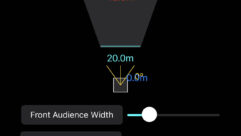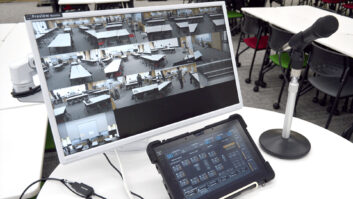Real Coverage, PART 3
Aug 1, 2001 12:00 PM,
Rick Kamlet
WHEN YOU FIND YOURSELF IN A STORE where the sound system is sub-standard, you can’t help but feel doubts about the company. Bad business sound is simply a turn off.
This is Part 3 in a series of articles about designing premium business music systems. Part 1 (March 2001) discussed steps to take before starting the design and pointed out that a loudspeaker’s polar specification does not reflect true coverage as installed. Part 2 (May 2001) focused on how to compute the maximum sound level of a proposed system and how to equalize it. Before we get futher into ceiling speaker layout patterns and spacing, you may wish to review Parts 1 and 2 (online at www.svconline.com).
SPEAKER LAYOUT PATTERNS
A number of different patterns can be used for laying out ceiling speakers, and each pattern can be implemented in different degrees of density. The pattern and density selected for an installation affect:
- Evenness of coverage
- Sound level capability of the system
- Intelligibility
- Cost of the system
- Power amplification requirements
The two basic, most widely used speaker patterns are square and hexagonal (also called offset or triangular).
Square Pattern
A square pattern lines up the rows and columns and often requires fewer speakers, resulting in a lower system cost. A square pattern is easy to lay out, especially on a suspended ceiling tile grid. It may also be easier for zoning large open spaces. It is usually the preferred choice, delivering more even coverage, and often with fewer speakers. It’s usually the best starting point for a design.
Hexagonal Pattern
In a hexagonal layout pattern, the rows are offset. While a hexagonal pattern typically uses more speakers, it may use fewer in some cases. For example, in a room laid out with a square pattern, the end speaker may cover only a small area. In a room where the width is 1.5 times the coverage of the speaker, part of a speaker’s coverage is wasted in the square pattern. In these cases, you might be able to reduce the number of speakers in each row by one and offset the rows from each other, with the offset speaker from one row partially filling in the uncovered area from the adjacent row. This sometimes can reduce the evenness of coverage, however.
SPEAKER DENSITY
The three most common density factors in speaker layout are edge-to-edge, minimum overlap and full overlap.
Edge-to-edge density places the speakers such that the outside edges of their single-speaker 6dB down points (as projected onto the listening plane) just touch one another. Minimum overlap is a tighter spacing where all spots are within the 6dB coverage pattern of at least one speaker. Full overlap is tighter still: the 6dB down point of one speaker extends to the on-axis point of adjacent speakers, and all listeners are within the coverage pattern of at least two speakers. See Figure 1.
Considerations for Selecting Layout Density
In general, higher speaker density increases the SPL capability by a little bit, overcomes ambient noise better, and reduces the variation in sound level throughout the space. Lower densities result in fewer speakers and lower system cost, but provide lower SPL capability, lessened ability to overcome ambient noise and greater variations in sound level within the space.
Spacing is a subtle art, but in a fairly dead room with low ambient noise and a relatively low SPL requirement, an edge-to-edge pattern will often suffice. In a room with a lot of reflective surfaces, high ambient noise and a paging or sound reinforcement requirement, minimum or full overlap is probably indicated. Full overlap should be used when a very high-quality sound reinforcement system is critical.
Budget may necessitate an edge-to-edge or wider spacing when a higher density would be desirable. In this case, the designer should inform the client of the ramifications before the system is installed.
Higher Sound Levels (SPL)
Tighter speaker densities allow for slightly higher SPL levels due to a greater number of speakers covering each area within the listening space. While the summation between adjacent speakers is incoherent, there is still some increase in SPL. See Table 1.
Level Variation Due to Layout Density
The speaker density also affects the amount of variation of the sound level within the listening space. The tighter the spacing, the more consistent the sound will be from place to place. Some off-axis locations will be lower by as much as the stated figure in Table 1.
For example, in a square pattern installation with edge-to-edge density, if the on-axis maximum SPL for music and speech (considering distance from the speaker and any additional SPL from layout density) is computed to be 92 dB, there will be some locations within the listening space that will be 4.4 dB lower at 87.6 dB.
Pay attention to level variation in a distributed system’s design. Don’t assume that every location within a listening space will be at the same level or achieve the same maximum SPL as directly under a speaker.
CONSIDER THE ENVIRONMENT
Audience Mobility
Seated audiences, as in a restaurant, can be bothered by excessive level variation throughout the space. One table might be disturbed by high sound levels while another can’t hear the music or paging. In applications where the listeners move around, there may be more tolerance to variations in coverage.
High Ceilings
For high-ceiling applications, it is often best to select a speaker that has somewhat narrow coverage. These tend to have higher sensitivity, allowing the sound to be more focused as it travels the distance from the high ceiling to the listening plane. In high-ceiling applications, you don’t want to hear mids or highs from speakers on the other side of the room. That adds to the reverberant noise field, degrades the intelligibility of speech and interferes with the coherence of music. If the ceilings are high and the room is large, severe intelligibility problems can develop. You shouldn’t hear much sound from any speaker whose path length to your ear is more than 30 feet longer than that of the closest speaker. The human aural system tends to integrate sounds that are heard within 30 milliseconds of each other, but sounds that are more than 30 milliseconds apart interfere with each other. To avoid this, it is simply best in high-ceiling applications to use narrow-coverage speakers.
NEXT TIME, THE GRAND FINALE
In Part 4, we will conclude with how to use subwoofers for business music applications, how many to use, how to cross them over and where to position them.
Rick Kamlet is the director of commercial sound for JBL Professional.










